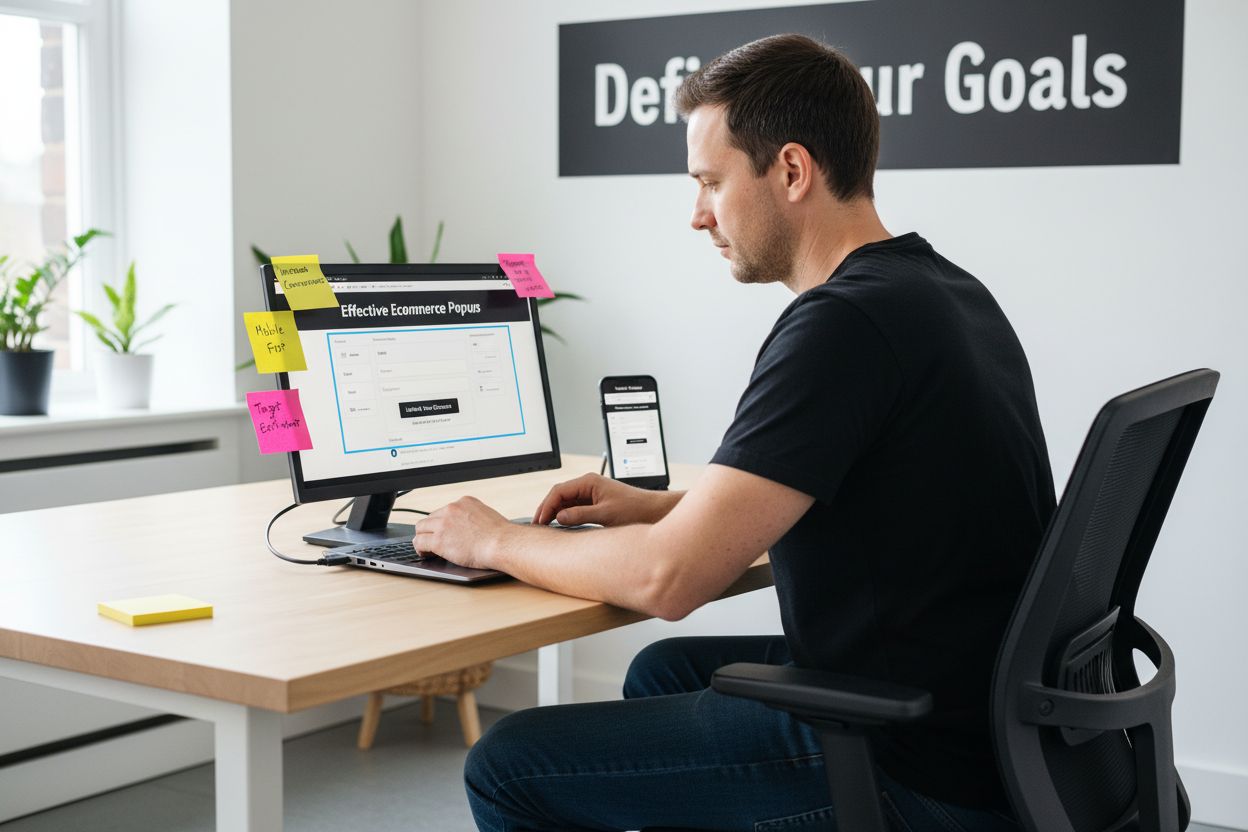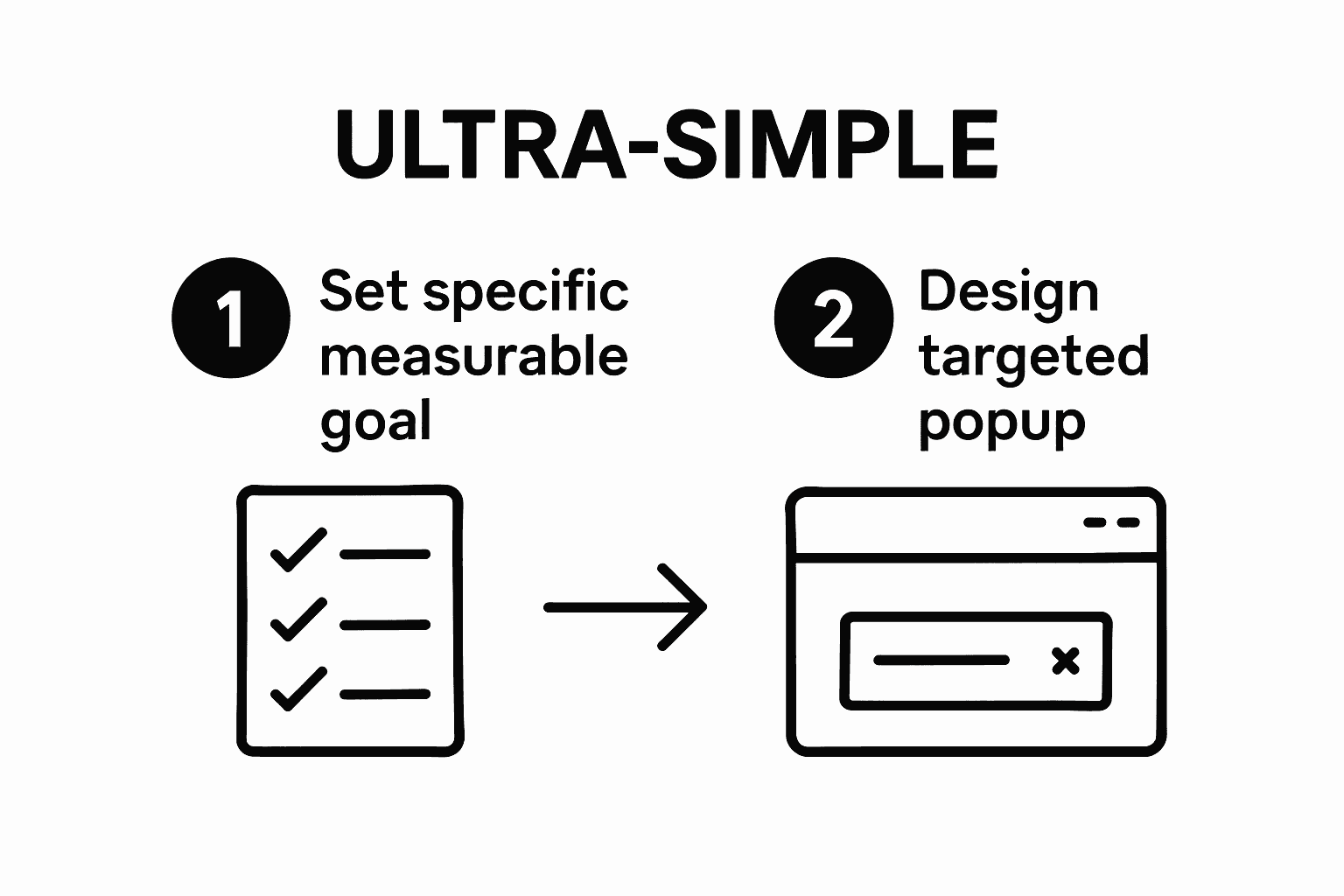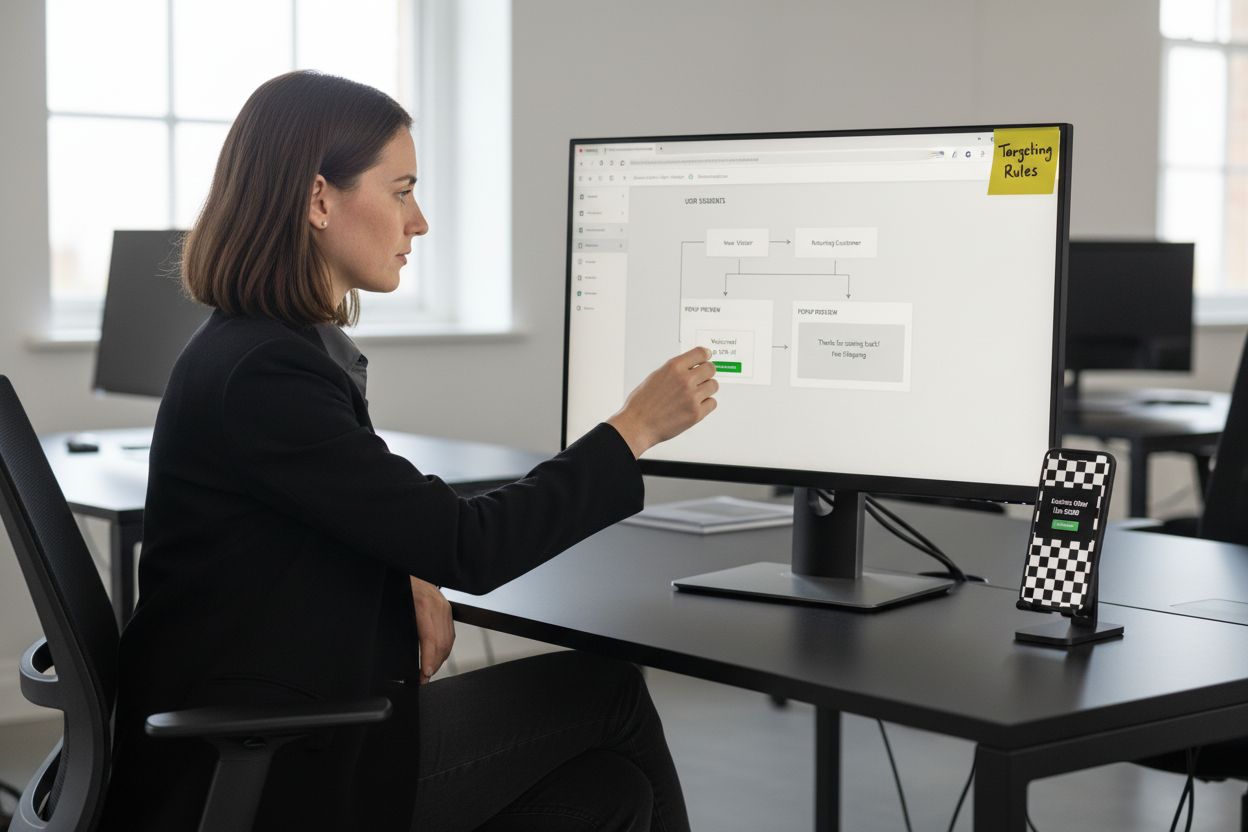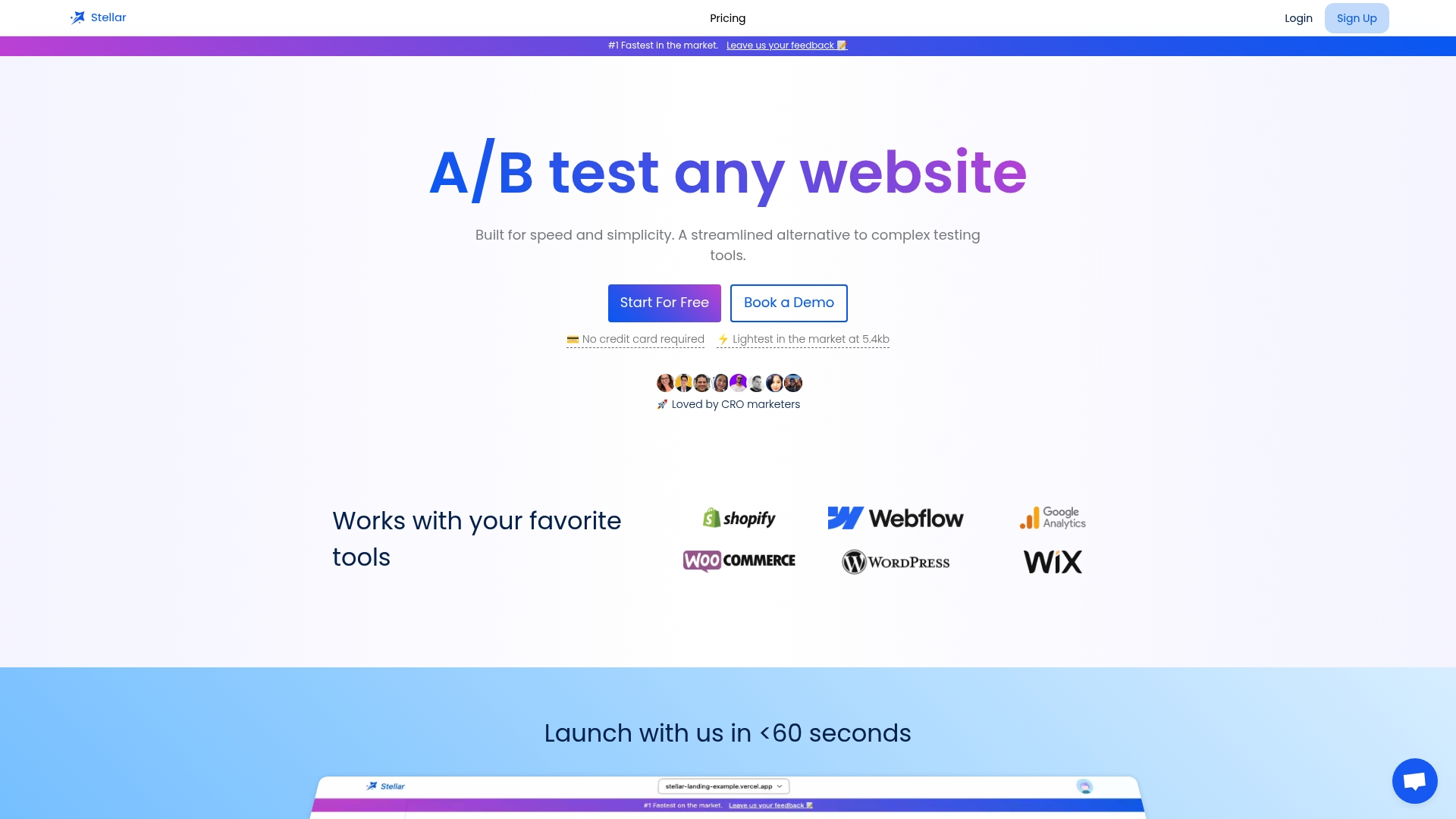
Create Effective Ecommerce Popups That Drive Sales

Ecommerce popups can be make or break for your online store. A single well-timed popup can slash cart abandonment rates by up to 15 percent or add hundreds of new email sign-ups every month. Most people see popups as annoying and intrusive. What if the right strategy actually turns them into one of your most powerful tools for growing sales and engaging shoppers?
Table of Contents
- Step 1: Define Your Goals For Ecommerce Popups
- Step 2: Choose The Right Popup Type For Your Strategy
- Step 3: Design Engaging And Compelling Popup Content
- Step 4: Set Up Targeting Rules For Maximum Impact
- Step 5: Test And Optimize Your Popups For Performance
Quick Summary
| Key Point | Explanation |
|---|---|
| 1. Define SMART Goals | Establish clear, specific, measurable objectives like reducing cart abandonment by 15%. |
| 2. Choose Appropriate Popup Types | Use time-triggered or exit-intent popups for increased relevance based on user behavior. |
| 3. Design Engaging Content | Ensure popups have clear, concise messaging that communicates immediate value to users. |
| 4. Implement Targeting Rules | Fine-tune popups based on user behavior, demographics, and device type for maximum impact. |
| 5. Test and Optimize Regularly | Conduct A/B testing to improve performance and adapt popups based on user response metrics. |
Step 1: Define Your Goals for Ecommerce Popups
Establishing clear objectives is the foundational step in creating effective ecommerce popups that genuinely drive sales and engagement. Before designing any popup, you need a precise understanding of what you want to accomplish. Successful popup strategies are always rooted in specific, measurable goals that align with your broader marketing and conversion objectives.
Start by identifying the primary purpose of your popup. Are you looking to capture email addresses, reduce cart abandonment, promote a limited time discount, or introduce first time visitors to your brand? Each goal requires a different strategic approach and design. For email list building, your popup might focus on offering a compelling lead magnet like a discount code or exclusive content. For cart abandonment, you'll want a popup that offers an immediate incentive to complete the purchase.
Your goals should be SMART: Specific, Measurable, Achievable, Relevant, and Time-bound. Instead of a vague goal like "increase conversions," aim for something concrete such as "reduce cart abandonment rate by 15% within three months" or "grow email subscriber list by 500 new contacts per month." These precise objectives will help you design targeted popups and track their performance effectively.

Consider your audience's stage in the customer journey when defining goals. A new visitor might need different popup messaging compared to a returning customer. Segmentation matters - what works for one audience segment may not resonate with another. Check out our guide on ecommerce optimization to understand how to create more nuanced, targeted popup strategies that speak directly to specific customer needs.
Once you've defined your goals, you'll be ready to move forward with designing popups that are not just visually appealing, but strategically crafted to drive real, measurable results for your ecommerce business.
Here is an overview table summarizing each main step for creating effective ecommerce popups, including their focus and what you can achieve at each stage.
| Step | Main Focus | Expected Outcome |
|---|---|---|
| Define Your Goals | Set SMART objectives | Clear, measurable targets for your popup strategy |
| Choose the Right Popup Type | Select optimal popup style | Appropriate timing and relevance for engagement |
| Design Engaging Popup Content | Craft headlines and visuals | Compelling, trust-building offers to drive action |
| Set Up Targeting Rules | Segment by behavior/demographics | Personalized experiences for each audience segment |
| Test and Optimize for Performance | A/B testing and analysis | Improved conversion through continuous optimization |
Step 2: Choose the Right Popup Type for Your Strategy
Selecting the appropriate popup type is crucial for transforming your ecommerce conversion strategy from generic to targeted. Different popup styles serve distinct purposes, and understanding their unique strengths will help you match the right approach to your specific goals. Your popup choice can dramatically influence how potential customers perceive and interact with your brand.
Time-triggered popups work exceptionally well for capturing visitor attention at critical moments. Exit-intent popups, which appear when a user's cursor moves towards closing the browser window, can be particularly effective for cart abandonment prevention. These strategic interruptions give you a final opportunity to engage customers who might otherwise leave without purchasing. Timing is everything - presenting the right message at the precise moment a visitor is about to disengage can recover potentially lost sales.
Scroll-based popups offer another nuanced approach, appearing after a visitor has consumed a specific percentage of page content. This method demonstrates respect for user engagement, only interrupting once they've shown genuine interest. For example, a popup offering a detailed product guide might appear after someone has scrolled 60% down a product page, indicating they're seriously considering the purchase. Explore our strategies for increasing conversions to understand how these targeted approaches can significantly improve your ecommerce performance.
When choosing your popup type, consider the user experience above all. Intrusive or repetitive popups can frustrate visitors and potentially drive them away. Aim for subtlety and value. A well-designed popup should feel like a helpful suggestion rather than an aggressive interruption. Mobile responsiveness is critical - ensure your chosen popup type looks and functions seamlessly across different devices and screen sizes. The most successful popups anticipate user needs, offering genuine value that feels personalized and timely, transforming what could be an annoying interruption into a welcome opportunity for engagement.
Below is a comparison table outlining the main types of ecommerce popup approaches discussed in the article, along with their key uses and interaction moments.
| Popup Type | Key Use Case | When It Appears | User Benefit |
|---|---|---|---|
| Time-Triggered | Grab attention after engagement | After a set time on site | Timely offer or info after browsing |
| Exit-Intent | Prevent cart abandonment | When cursor moves to close window | Last-second incentive to complete purchase |
| Scroll-Based | Engage interested visitors | After scrolling a set percentage of page | Targeted content based on engagement |
| Device-Specific | Optimize for mobile or desktop | Based on device being used | Better user experience, tailored offers |
| Referral-Based | Special offer for certain sources | If visitor arrives via specific referral | Personalized deal or message |
Step 3: Design Engaging and Compelling Popup Content
Crafting popup content that captures attention and drives action requires a strategic blend of psychology, design, and clear communication. Your popup needs to communicate value instantly, creating an irresistible proposition that compels visitors to engage. The most effective popups speak directly to customer needs, offering solutions or benefits that feel personalized and timely.
Clarity and brevity are your most powerful tools. Visitors decide within seconds whether to engage with your popup, so every word must count. Your headline should be direct and promise a clear benefit. Instead of generic statements, use specific language that highlights the unique value proposition. For instance, rather than saying "Sign up for our newsletter," try "Get 20% off your first purchase and exclusive styling tips." This approach transforms a mundane request into an attractive offer that feels tailored to the user's interests.
Visual design plays an equally critical role in popup effectiveness. Color psychology matters significantly - choose colors that align with your brand while creating emotional resonance. Warm colors like orange and red can create urgency, while blues communicate trust and professionalism. Learn more about designing high-converting landing pages to understand how design principles can dramatically improve user engagement. The visual hierarchy should guide the user's eye naturally towards the call to action, using strategic placement, contrasting colors, and clean, readable fonts.
Authenticity builds trust, so incorporate elements that make your popup feel genuine. Customer testimonials, trust badges, or real product images can transform a generic popup into a compelling interaction. Remember that transparency wins. Clearly communicate what users will receive, how their information will be used, and the immediate value they'll gain. A popup that feels honest and straightforward is far more likely to convert than one that seems manipulative or overly aggressive. Your ultimate goal is creating a popup experience that feels less like an interruption and more like a helpful, personalized recommendation.
Step 4: Set Up Targeting Rules for Maximum Impact
Targeting rules transform generic popups into precision marketing tools that speak directly to specific audience segments. The more granular and intelligent your targeting, the higher your potential for converting casual browsers into committed customers. Sophisticated targeting is about understanding user behavior, not just demographics.
Start by leveraging website behavioral data to create nuanced targeting strategies. New visitors might need different popup messaging compared to returning customers or those who have already added items to their cart. Consider creating unique popup experiences based on user journey stages. For instance, first time visitors could receive a welcome discount, while returning customers might see a popup highlighting complementary products related to their previous purchases. Tracking user interactions like page views, time spent on site, and scroll depth allows you to build sophisticated targeting rules that feel personal and relevant.
Technical targeting options provide powerful segmentation capabilities. You can configure popups to appear based on complex conditions such as traffic source, geographic location, device type, or even specific referral links. Precise targeting minimizes popup fatigue and increases relevance. For example, mobile users might see a differently structured popup compared to desktop visitors, ensuring optimal user experience across devices. Explore our comprehensive conversion optimization strategies to understand how advanced targeting can revolutionize your ecommerce approach.
Frequency and timing are critical components of effective targeting. Implement rules that prevent popup bombardment, such as limiting appearance to once per user session or waiting a specific duration between displays. Consider creating smart rules that recognize returning visitors, offering progressively more personalized experiences without becoming intrusive. The goal is creating a targeting strategy that feels helpful and intuitive, anticipating user needs before they explicitly articulate them. By treating each popup as a sophisticated, contextually aware interaction rather than a generic interruption, you'll develop a targeting approach that genuinely enhances user experience while driving meaningful conversions.

Step 5: Test and Optimize Your Popups for Performance
Testing and optimization are the critical final steps that transform good popups into exceptional conversion engines. Continuous improvement is the cornerstone of successful popup strategies. Without systematic testing, you're essentially operating in the dark, missing opportunities to enhance your popup performance and drive meaningful engagement.
A/B testing provides the most powerful mechanism for understanding popup effectiveness. Create multiple variations of your popup, changing one element at a time - whether it's headline text, color scheme, offer structure, or call to action placement. Track key metrics like conversion rate, engagement time, and bounce rate to determine which version resonates most with your audience. Pay close attention to subtle nuances. Sometimes a minor tweak in wording or visual design can dramatically improve popup performance. For instance, changing from a generic "Sign Up" to a more specific "Claim Your Exclusive Discount" can significantly increase user interaction.
Explore our guide on improving landing page performance to understand how similar optimization principles apply across digital marketing strategies. When conducting tests, maintain a structured approach. Begin by establishing clear baseline metrics, then introduce variations systematically. Remember that statistical significance is crucial - ensure you have enough data points to draw meaningful conclusions. Most popup tools recommend running tests for at least two weeks or until you've collected several hundred interactions to ensure reliable insights.
Beyond A/B testing, implement comprehensive performance tracking. Monitor critical metrics like popup display rate, interaction rate, and conversion impact. Look for patterns in user behavior - are certain targeting rules generating more engagement? Do specific time frames or user segments respond more positively? The most successful popup strategies evolve continuously, treating each test as an opportunity to refine and improve. Your ultimate goal is creating a dynamic, responsive popup system that adapts seamlessly to changing user preferences and behaviors, transforming what could be an intrusive element into a genuinely valuable user experience.
Supercharge Your Ecommerce Popups With Effortless A/B Testing
You have read how defining goals, choosing the right popup type, and constant optimization are essential for winning more sales through ecommerce popups. But actually turning those great ideas into real improvements can feel overwhelming. Testing headlines, colors, and offers one after another can be a hassle, and outdated tools often slow your site or stop you from making quick changes. The frustration builds when you cannot prove what is working and what needs to change.

Experience the difference with Stellar. Streamline your popup experimentation with an easy-to-use visual editor and real-time analytics made just for marketers who want clear results fast. Test every element without slowing your site or needing developers. Stop guessing and know exactly which popups boost your conversions.
Take the next step to higher-performing popups by trying Stellar today. Discover why our platform helps small and medium businesses like yours run smarter and faster experiments. Visit Stellar's home page now and start optimizing your ecommerce popups with confidence.
Frequently Asked Questions
What are the key goals I should define for my ecommerce popups?
Clearly defined goals are essential for effective popups. Focus on SMART objectives, such as reducing cart abandonment by a specific percentage or growing your email subscriber list. These measurable goals will guide your popup design and strategy.
How do I choose the right type of popup for my ecommerce store?
Selecting the right popup type depends on your objectives. Time-triggered and exit-intent popups are great for capturing attention at critical moments, while scroll-based popups engage visitors who show genuine interest. Make sure to match the popup to your specific goals for maximum impact.
What should I include in the content of my ecommerce popups?
Effective popup content should be clear and concise, conveying an immediate value proposition. Use compelling headlines that promise benefits, and ensure visual design aligns with your brand. Incorporate elements that build trust, like customer testimonials or real product images, to improve conversion rates.
How can I optimize my popups after they are implemented?
To optimize your popups, conduct A/B testing on different elements like headlines, design, and calls to action. Monitor critical metrics such as conversion rates and user engagement to identify areas for improvement. Continuous testing will help you refine your popup strategy for better performance.
Recommended
- Boost Your Ecommerce Conversion Rate: Proven Tactics for More Sales
- The Ultimate Guide to eCommerce Optimization
- Ecommerce Navigation Optimization Guide for 2025 Success
- A/B Testing for Ecommerce: Strategies and Trends for 2025
- 5 Ways To Increase Your eCommerce Conversion Rate - Paul Baguley
- Improve E-commerce conversion rate: 10 quick CRO hacks - WPMarketingRobot
Published: 10/1/2025